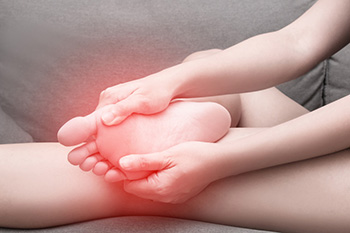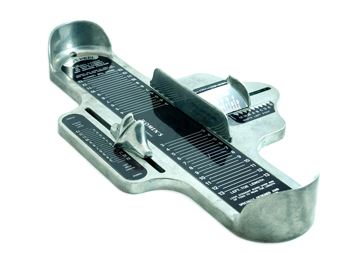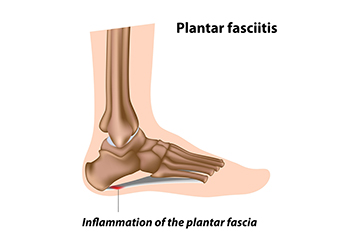Items filtered by date: March 2023
What Are the Feet Responsible For?

The onset of warm weather in many parts of the world may bring the desire to lose the shoes and walk barefoot. It can be interesting to look closely at the feet, which is often done during the day while the shoes are off. Each foot has 26 bones, several tendons, muscles, and ligaments that work together to make the foot move. The joints in the feet enable the bones to change position, and they are held together by portions of tissues that are stretched between the bones. The soles of the feet have thicker skin than the rest of the body, and they are designed to absorb the weight of the body. The various components of the feet work together to balance and support the body, in addition to providing the ability to move from place to place. If you would like additional information about how the feet are designed, it is suggested that you consult with a podiatrist who can provide you with the information you are seeking.
If you have any concerns about your feet, contact Leonora Fihman, DPM from California. Our doctor can provide the care you need to keep you pain-free and on your feet.
Biomechanics in Podiatry
Podiatric biomechanics is a particular sector of specialty podiatry with licensed practitioners who are trained to diagnose and treat conditions affecting the foot, ankle and lower leg. Biomechanics deals with the forces that act against the body, causing an interference with the biological structures. It focuses on the movement of the ankle, the foot and the forces that interact with them.
A History of Biomechanics
- Biomechanics dates back to the BC era in Egypt where evidence of professional foot care has been recorded.
- In 1974, biomechanics gained a higher profile from the studies of Merton Root, who claimed that by changing or controlling the forces between the ankle and the foot, corrections or conditions could be implemented to gain strength and coordination in the area.
Modern technological improvements are based on past theories and therapeutic processes that provide a better understanding of podiatric concepts for biomechanics. Computers can provide accurate information about the forces and patterns of the feet and lower legs.
Understanding biomechanics of the feet can help improve and eliminate pain, stopping further stress to the foot.
If you have any questions please feel free to contact our offices located in Encino and Brentwood, Los Angeles, CA . We offer the newest diagnostic and treatment technologies for all your foot and ankle needs.
Metatarsalgia and Pain in the Sole of the Foot

Metatarsalgia is the medical name for pain that happens to the ball of the foot. It is found under the toes, on the bottom of the foot. The feet bear the weight of the body, and the soles of the feet are often affected. There are 26 bones in each foot, and they are divided into categories. Additionally, the tendons, muscles, and ligaments comprise the arch of the foot, and the nerves control the sensation in the skin. There are several reasons why many people experience metatarsalgia, or foot pain. These can include obesity, wearing shoes that do not fit correctly, or specific medical conditions. Morton’s neuroma can happen from wearing shoes that are too tight, such as high heels. This can cause the toes to squeeze together, affecting the nerve that is located between the third and fourth toes. The pain from this condition is often felt in the ball of the foot. A stress fracture can happen to the metatarsal bones in the foot, and it can be felt in the bottom of the foot. If you have foot pain, it is suggested that you seek the counsel of a podiatrist who can effectively diagnose and treat the condition appropriately.
Foot Pain
Foot pain can be extremely painful and debilitating. If you have a foot pain, consult with Leonora Fihman, DPM from California. Our doctor will assess your condition and provide you with quality foot and ankle treatment.
Causes
Foot pain is a very broad condition that could be caused by one or more ailments. The most common include:
- Bunions
- Hammertoes
- Plantar Fasciitis
- Bone Spurs
- Corns
- Tarsal Tunnel Syndrome
- Ingrown Toenails
- Arthritis (such as Gout, Rheumatoid, and Osteoarthritis)
- Flat Feet
- Injury (from stress fractures, broken toe, foot, ankle, Achilles tendon ruptures, and sprains)
- And more
Diagnosis
To figure out the cause of foot pain, podiatrists utilize several different methods. This can range from simple visual inspections and sensation tests to X-rays and MRI scans. Prior medical history, family medical history, and any recent physical traumatic events will all be taken into consideration for a proper diagnosis.
Treatment
Treatment depends upon the cause of the foot pain. Whether it is resting, staying off the foot, or having surgery; podiatrists have a number of treatment options available for foot pain.
If you have any questions, please feel free to contact our offices located in Encino and Brentwood, Los Angeles, CA . We offer the newest diagnostic and treatment technologies for all your foot care needs.
Am I Wearing the Right Shoe Size?

There are various ways to determine your shoe size and ensure a proper fit. Using a Brannock device is an effective measuring tool that is found in most shoe stores. However, many people opt to know their shoe size before going to the store and this can be accomplished at home. The first step is to trace the foot on a piece of paper while wearing the intended socks. This is followed by using a size conversion chart and matching the length of the traced foot to its corresponding size. When a shoe fits properly, there is adequate room for the toes to move freely, and the heel and midfoot fit snugly. It is beneficial to measure the feet each time new shoes are purchased. The best time of day to measure the feet is in the afternoon when the feet are at their largest. If you would like more information on how to find shoes that fit properly, please speak with your local podiatrist.
Finding a properly-fitting shoe is important in reducing injuries and preventing foot problems. For more information about treatment, contact Leonora Fihman, DPM from California. Our doctor will treat your foot and ankle needs.
Proper Shoe Fitting
A common concern when it comes to foot health, having properly fitted shoes can help prevent injuries to the foot. Out feet affect our posture and gait, which in turn affects the biomechanics and overall bodily structure. With 33 joints, 26 bones, and over 100 ligaments, the potential for serious injury is much greater than one realizes. Although the feet cease growth in adulthood, they still change shape as they mature. Here are some factors to consider when it comes to investing in proper fitting shoes:
- Be sure the shoes fit correctly right away
- Ensure the ball of your foot fits comfortably in the widest portion of the shoes
- Even though they may look fashionable, improper fitting shoes can either create adverse conditions or exacerbate existing ones you may already have
- Walk along a carpeted surface to ensure the shoes comfortably fit during normal activity
Keeping in mind how shoes fit the biomechanics of your body, properly-fitting shoes are vitally important. Fortunately, it is not difficult to acquire footwear that fits correctly. Be sure to wear shoes that support the overall structure of your body. Do your feet a favor and invest in several pairs of well-fitted shoes today.
If you have any questions please feel free to contact our offices located in Encino and Brentwood, Los Angeles, CA . We offer the newest diagnostic and treatment technologies for all your foot and ankle needs.
Simple Relief Techniques for Plantar Fasciitis

Patients who have developed plantar fasciitis often look to find relief. It is a condition that is characterized by heel pain, and it may affect the Achilles tendon. Plantar fasciitis is an inflammation of the plantar fascia, which is the band of tissue that connects the heels to the toes. It is located on the soles of the feet, and can happen from standing on hard surfaces for the majority of the day. Additionally, wearing shoes that do not have adequate support may contribute significantly to getting plantar fasciitis. Many people choose to ignore the aches that this condition often begins with, and this may extend the recovery period. There are simple stretching techniques that may help to reduce the pain from plantar fasciitis. A stretch for the plantar fascia is done by rolling the affected foot on a tennis ball or frozen water bottle. A standing heel raise is also an effective stretch. This is accomplished by standing on a step, while lowering heels one at a time until a gentle stretch is felt. Plantar fasciitis is a serious foot condition, and it is suggested that you are under the care of a podiatrist who can help you with effective relief methods.
Plantar fasciitis is a common foot condition that is often caused by a strain injury. If you are experiencing heel pain or symptoms of plantar fasciitis, contact Leonora Fihman, DPM from California. Our doctor can provide the care you need to keep you pain-free and on your feet.
What Is Plantar Fasciitis?
Plantar fasciitis is one of the most common causes of heel pain. The plantar fascia is a ligament that connects your heel to the front of your foot. When this ligament becomes inflamed, plantar fasciitis is the result. If you have plantar fasciitis you will have a stabbing pain that usually occurs with your first steps in the morning. As the day progresses and you walk around more, this pain will start to disappear, but it will return after long periods of standing or sitting.
What Causes Plantar Fasciitis?
- Excessive running
- Having high arches in your feet
- Other foot issues such as flat feet
- Pregnancy (due to the sudden weight gain)
- Being on your feet very often
There are some risk factors that may make you more likely to develop plantar fasciitis compared to others. The condition most commonly affects adults between the ages of 40 and 60. It also tends to affect people who are obese because the extra pounds result in extra stress being placed on the plantar fascia.
Prevention
- Take good care of your feet – Wear shoes that have good arch support and heel cushioning.
- Maintain a healthy weight
- If you are a runner, alternate running with other sports that won’t cause heel pain
There are a variety of treatment options available for plantar fasciitis along with the pain that accompanies it. Additionally, physical therapy is a very important component in the treatment process. It is important that you meet with your podiatrist to determine which treatment option is best for you.
If you have any questions, please feel free to contact our offices located in Encino and Brentwood, Los Angeles, CA . We offer the newest diagnostic and treatment technologies for all your foot care needs.

